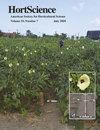7个高单宁苹果酒品种果皮削薄提高果汁品质
IF 1.6
3区 农林科学
Q2 HORTICULTURE
引用次数: 0
摘要
在3年多的时间里(2016-18),对7个高单宁苹果(Malus×domestica Borkh.)品种的树木生产力、两年结果、返青和果实质量进行了评估。对七个品种中的每一个都进行了五种处理的评估:所有果实的手工减薄(零作物负荷处理);人工减薄至3、6或9个果实/cm2树干横截面积的作物密度(TCSA);或未经处理。在本文中,我们报道了三种非零作物负荷处理和未处理对照的果实成熟度和果汁品质特性的分析。作物负荷对果实成熟度的影响,通过淀粉模式指数和采前下降来衡量,是品种依赖性的。作物密度(果实/cm2 TCSA)对所有果实成熟度和汁液质量变量都有显著影响,尽管在初始结实率较低的“淡季”(2017年),对整个种植的影响最弱。随着作物密度的增加,7个品种汁液中的总多酚、可滴定酸度、可溶性固形物和伯氨基氮含量均下降。一项部分预算分析表明,仅由于伯氨基氮浓度的增加而降低的氮补充剂成本并不能证明化学或手工稀释的成本是合理的。通过将第四年的春季开花密度外推到收获时的潜在水果产量,我们发现,从长远来看,减少作物负荷预计会增加每棵树的累计多酚总产量。对于本实验中的品种,发现9个果实/cm2的目标作物密度可以充分降低两年期的结果,同时也不会降低硬质苹果酒生产的果汁质量。单宁含量高的苹果种植者在做出作物负荷管理决策时,应考虑果汁质量,尤其是单宁产量。本文章由计算机程序翻译,如有差异,请以英文原文为准。
Fruitlet Thinning Improves Juice Quality in Seven High-tannin Cider Cultivars
Over 3 years (2016–18), tree productivity, biennial bearing, return bloom, and fruit quality were evaluated for seven high-tannin cider apple (Malus ×domestica Borkh.) cultivars. Five treatments were evaluated on each of the seven cultivars: hand-thinned of all fruit (a zero crop load treatment); hand-thinned to crop densities of three, six, or nine fruit/cm2 trunk cross-sectional area (TCSA); or left unthinned. In this paper, we report on the fruit maturity and juice quality properties that were analyzed for the three nonzero crop load treatments and the unthinned control. The effects of crop load on fruit maturity, as measured by starch pattern index and preharvest drop, were cultivar dependent. Crop density (fruit/cm2 TCSA) had a significant effect on all fruit maturity and juice quality variables, although effects were weakest in the “off” year (2017) for the whole planting when initial fruit set was low. As crop density increased, total poly phenols, titratable acidity, soluble solids, and primary amino nitrogen decreased in the juice of all seven cultivars. A partial budget analysis indicated that the reduced costs of nitrogen supplements due to increased primary amino nitrogen concentration alone would not justify cost of chemical or hand-thinning. By extrapolating the spring flowering density in the fourth year to potential fruit yields at harvest, we found that reducing crop load was projected to increase cumulative total polyphenol yields per tree over the long term. For the cultivars in this experiment, a target crop density of nine fruit/cm2 was found to adequately decrease biennial bearing while also not diminishing juice quality for hard cider production. High-tannin cider apple growers should consider juice quality, particularly tannin production, when making crop load management decisions.
求助全文
通过发布文献求助,成功后即可免费获取论文全文。
去求助
来源期刊

Hortscience
农林科学-园艺
CiteScore
3.00
自引率
10.50%
发文量
224
审稿时长
3 months
期刊介绍:
HortScience publishes horticultural information of interest to a broad array of horticulturists. Its goals are to apprise horticultural scientists and others interested in horticulture of scientific and industry developments and of significant research, education, or extension findings or methods.
 求助内容:
求助内容: 应助结果提醒方式:
应助结果提醒方式:


